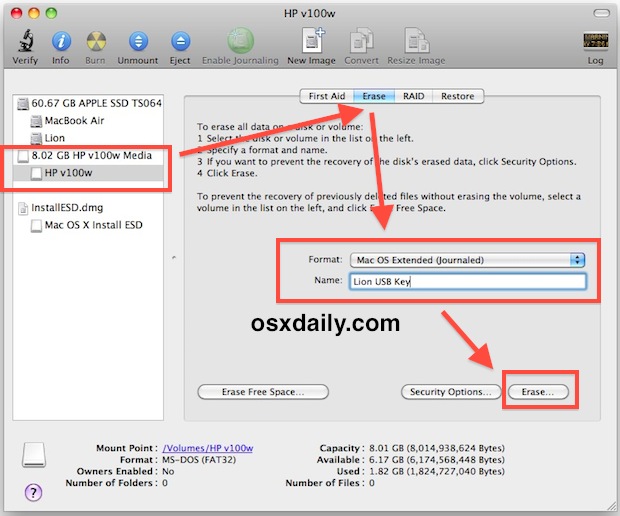

- HOW TO REFORMAT A USB DRIVE ON A MAC HOW TO
- HOW TO REFORMAT A USB DRIVE ON A MAC MAC OS X
- HOW TO REFORMAT A USB DRIVE ON A MAC INSTALL
- HOW TO REFORMAT A USB DRIVE ON A MAC PRO
APM is an older, Mac-only partition scheme. Here I show how to reformat your thumb drive (or hard drive) to ExFAT format so that you can transfer larger files to. You’ll also be asked to choose between a partition scheme: GUID Partition Map, Master Boot Record, or Apple Partition Map. When you open the Disk Utility, the tool will look like below: Select the preferred USB Drive from the menu on the left side of the screen. RELATED: What's the Difference Between GPT and MBR When Partitioning a Drive?
HOW TO REFORMAT A USB DRIVE ON A MAC INSTALL
It’s not natively supported on many Linux distributions, but you can install exFAT support on Linux.įor external drives, it almost always makes sense to format in ExFAT, unless you’re using the drive for Time Machine. ExFAT is the ideal cross-platform file system. You should use this file system if you may share the drive with Windows PCs and other devices like the PlayStation 4 and Xbox One consoles.

HOW TO REFORMAT A USB DRIVE ON A MAC MAC OS X
By default, Mac OS X doesn’t use a case-sensitive file system. You can use this feature to format a USB drive to your needed file system. Unlike Windows operating system, the Mac Disk Utility app doesn’t have a disk management feature called Format. Step 2: Use Disk Utility to Format a USB to exFAT on Mac. OS X Extended (Case-sensitive, Journaled): On a case-sensitive file system, “file” is different from “File”. If you want to back up the USB drive on your Mac computer, you can use Time Machine, a Mac built-in backup software, to perform a USB backup.This file system is necessary if you plan on using the drive for Time Machine backups–otherwise, you’ll want to use exFAT for maximum compatibility. OS X Extended (Journaled): This is the default, but it’s only natively supported on Macs.RELATED: What's the Difference Between FAT32, exFAT, and NTFS? You’ll need to choose between several file systems: You’ll be asked to provide a name for the disk, which will appear and identify the disk when you connect it to a Mac, PC, or another device. Select the drive by clicking its name.Ĭlick the “Erase” button after selecting the entire drive to erase the entire drive and create a single partition on it. Your connected drives will appear under “External” in the Disk Utility’s sidebar. Finally, click on OK and then select Erase.This is a complete process of formatting a USB drive on Mac.You can also open a Finder window, select “Applications” in the sidebar, and head to Utilities > Disk Utility. But keep in mind this step will increase the time of the format.Ħ. This will let you choose how securely you want the files to be deleted.Just move the slider to right, the further it moves, the more passes the erase feature will make meaning that the files will be removed discreetly. Next from the drop-down menu, select the type of format you want.If the USB flash drive, has some sensitive data, click on Security tab. Now select Erase from toolbar that is situated at top of window.Next a window will drop down here type a specific name for formatted drive.ĥ. Next navigate to Applications and select Utilities, then select Disk Utility by double-clicking on it.Ĥ. Note: – Formatting will wipe the entire data, so make sure the drive contains no important data on it.
HOW TO REFORMAT A USB DRIVE ON A MAC PRO
The latest MacBook Pro or MacBook Air have only USB-C type connectors, so if you have the recent Mac’s, you will require an adaptor to convert from USB-C to USB-A.Ģ. To format a USB drive, follow these steps:ġ.


 0 kommentar(er)
0 kommentar(er)
